
7 minute read
An Engineer’ s Day Out T h r e e P h a s e t o t h e Pe a k s t h e G o r n e r g r a t R a i l w a y, S w i t ze r l a n d
For this ar ticle Mr and Mrs Backhouse took their first ever package holiday to see an historic mountain railway, the Zermatt to Gornergrat rack railway which opened in 1898 Using the Abt rack system it was the first electrically powered mountain railway and used three phase electricity Still flourishing today it offers spectacular views of the Matterhorn and other peaks (photo 1).
British tourists discovered Switzerland in the 19th century; they enjoyed the scenery but complained about hotel quality and overcharging (Swiss hotels are now excellent but tourists still complain about Swiss prices ) Their holidays often involved mountain walking and climbing Even Queen Victoria ascended the Rigi, but on a pony
As railways and lake steamers developed, more tourists came - Thomas Cook brought his first party to Swit erland in 1863 - and local people saw business opportunities Inspired by America’s Mount Washington Cog Railway, Nicholas Riggenbach devised his own ladder-like rack and cogwheel railway which opened up the Rigi in 1875. Other rack systems followed; Roman Abt devised a system with two racks with milled teeth, offset, and a double pinion on the locomotive (photo 2) First used in 1885, it is commonly utilised today including on the Snowdon Mountain Railway Edward Locher invented his system to ascend Mount Pilatus, still the steepest cogwheel railway, opened in 1889 That had two racks placed horizontally with cogwheels engaging on either side. The Strub system uses a single rack. These mountain rack railways were worked by steam power and were only later converted to electric operation, although the Brienz-Rothorn Bahn remains mostly steam worked with modern oil fired locomotives plus some diesels
Reaching Zermatt
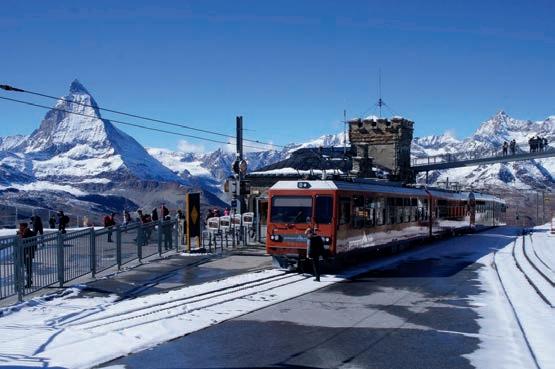
Ironically, publicity surrounding dward Whymper’s first ascent
At frst it operated summer only as winter sports had not then developed in the Zermatt area. Photo courtesy Matterhorn-Gotthard and tragic descent of the Matterhorn in 1865 brought more visitors to Zermatt
Visitors still walked or rode up the Mattertal Valley but in 1888 work began on a line from Visp where it met standard gauge tracks The Bundesrat (Swiss Federal Council) insisted on metre gauge rather than the narrower gauge originally proposed



A special commission investigated possible systems and the Abt rack system was chosen By July 1891 the railway had reached Zermatt (photo 3) but operation remained summer only as Zermatt hotels did not open in winter until 1927/28


Large scale winter sport is a comparatively recent development in Switzerland

Like other Swiss lines the railway was steam operated at first (photo 4) but coal shortages and rising costs during the First World War encouraged interest in electrification (Swit erland has few and limited coal deposits). From October 1929 it was electrified using ,000 volts AC. This was chosen rather than the ,000 AC of the Federal Railways as transformers could be air rather than oil cooled and therefore lighter which is important on a steeply graded line
The route of the railway was susceptible to rockfalls and Valais Canton funded shelters from 1933 which enabled yearround operation Along this spectacular line, large scale works also provided protection against floods and avalanches
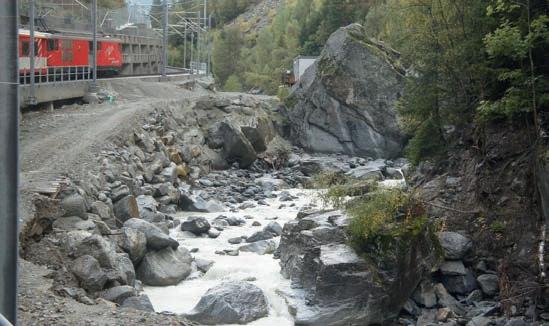
(photo 5)
Passengers changed at Visp for standard gauge trains but a metre gauge track was added in 0 enabling the first through ‘Glacier xpress’ to run from St Moritz to Visp and Zermatt via the Rhaetian Railway and Furka-Oberalp lines (photo 6) This still operates today and ‘panoramic’ coaches afford spectacular views Some trains include dining cars and the jouney is marketed as a luxury travel experience, drawing visitors from around the world A party of Americans were enjoying their meal during our trip. (More thrifty travellers should purchase provisions at one of the excellent local Co-ops before boarding )
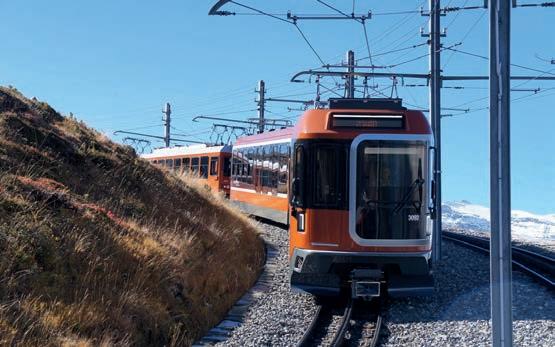


Building the GornergratMonte Rosa Bahn

Plans for a mountain railway from Zermatt were initially opposed locally due to the expected effects on employment of mountain guides and porters The Federal Government disregarded such fears as they had proved groundless in the Bernese Oberland so construction of the metre gauge GornergratMonte Rosa Bahn with Abt rack system began in 1898 by a private company

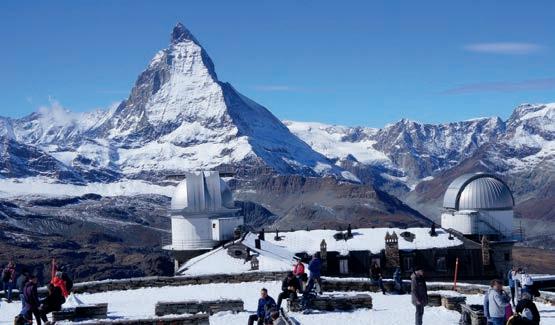
Like other Swiss Railways, much work was done by Italian labourers whose story is often overlooked Since the Gornergrat is at a high altitude and usually temperatures are low, most construction was limited to the summer season but even so, the performance of the workers was compromised due to the altitude However, there seems to have been greater care taken of the workforce than on other railway construction. (Thirty men died building the Jungfraujoch Railway ) A steam locomotive was used in construction and is now preserved in Spain
On the line’s 5¼ mile (8 5km) route there is one example of major civil engineering the 0 metre long Findelbach gorge bridge (photo 7) Originally intended as a stone viaduct with 48 metre (157 feet) high pillars the design was changed to a cantilevered steel design There are four tunnels and more recently snow sheds have been added to protect the line from avalanches, particularly in the higher parts of the line One snow shed is nearly half a mile long (792metres) In these mountains an avalanche may not be powdery snow but highly damaging, hard packed ice bringing rocks down (photo 8) n 0 August the railway opened to Gornergrat
(photo 9) as the second electric mountain railway in the world (photo 10) By 0 the line had extended higher up the Gornergrat and a summit hotel opened soon after. The two astronomical observatories were added in the late 60s and subsequently used for a range of observations including solar neutron detection (photo 11)
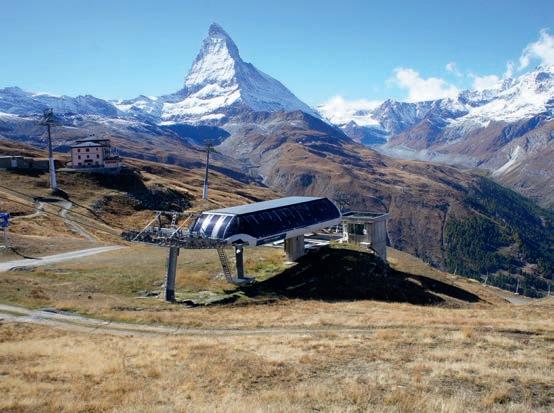
Operation today
This is a slick and efficient railway employing over a hundred people and carrying nearly two million passengers a year Now part of the Matterhorn-Gotthard Bahn group the line can convey up to ,400 people an hour in each direction taking just 33 minutes for the journey As usual on mountain rack railways upward speeds (max 0kph) are higher than those descending ( 027kph) More modern stock is allowed a faster descent
The double track, metre gauge line rises from Zermatt at 60 metres above sea level (5265 feet) to Gornergrat at 0 metres ( 0, feet) with four intermed iate stations Average gradient is in ( 0 ) It is the second highest station in Europe and the highest in the open. (The Jungfraujoch line and stations are in tunnels )
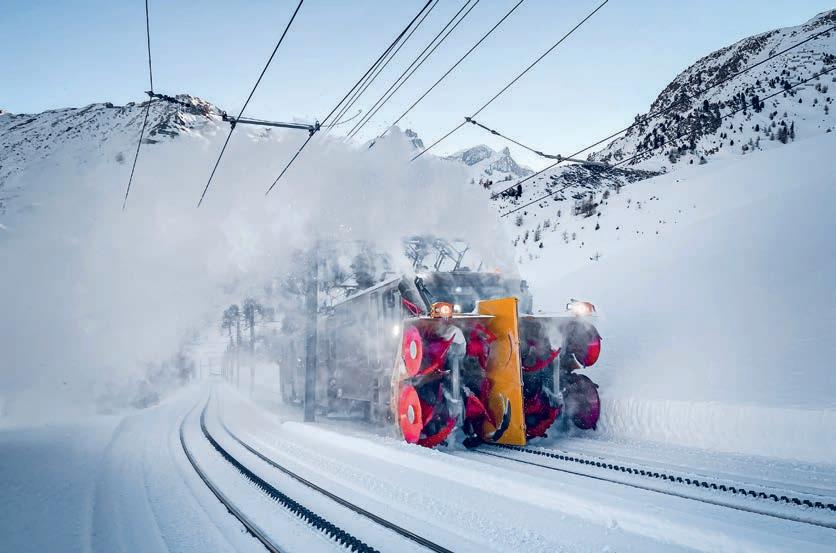
At first trains operated with locomotives pushing the train (photo 12) but now railcars are used (photos 10 and 13) These have space and racks for skis Recently the line has taken delivery of state of the art Stadler ‘Polaris’ railcars (photo 14) Even a short mountain railway is difficult to maintain all year round so the railway has a number of works wagons including water tankers, a crane truck and wagons for materials (photo 15) Most spectacular are the two snow blowersthough few will see them in action They feature in an audiovisual presentation in Gornergrat summit buildings (photo 16)
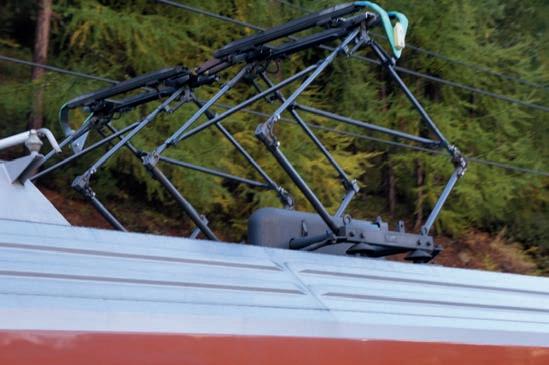
Electric power
As in 1898, electricity for the line is still generated at a hydro-electric power station in Zermatt Trains use three phase electricity at 725 volts AC which explains the unusual two wire overhead and the double pantographs (photo 17) This system was chosen in 1898 following an evaluation of four different types of power supply
Three phase electricity means that since its opening, locomotives and railcars have been equipped for regenerative braking now using asynchronous motors Energy generated coming down is fed back to the overhead, enabling two downward trains to power at least one train going up, so avoiding energy consuming brakes
A typical three-phase power distribution system has three line phases and one neutral For a perfectly balanced three- phase load (such as a train motor) the phases balance out and the neutral carries the zero current and can therefore be omitted At a local level the three-phase power is transformed down to a lower voltage, with the transformer secondary giving three outputs phase to phase


This is star connection as the three phases radiate out from the neutral point like a star, with each phase being 0 degrees apart from the next phase Neutral is connected to earth at the substation The voltage between each phase and the neutral is 419 volts which is 725 divided by the square root of three (1 73) As the neutral is earthed at the substation, each phase is always 419 volts above earth
The transformer has one phase connected to earth instead of the star point, so that running rails are earthed and the two overhead wires are connected to the other two phases The star point is not connected to anything other than one end of each of the three windings and therefore ‘floats’ at whatever voltage it is There is no neutral connected to the star as the load, being a motor, is always balanced, so there is no need for a neutral With three-phase, electricity power output from the motor is constant and for a rack railway, variable speed drives are not ne eded These are not fast lines The power is controlled using solid state electronics when starting up until it is running at full speed
Originally the line had wooden poles to carry overhead wires but these have since been replaced by galvanised steel posts
Other engineering en route
Several ski lifts operate from the line during winter as at
Riffelberg (photo 18) Claimed as being Europe’s highest and shortest tramway, a 2 foot gauge battery powered line links Riffelalp station to the nearby hotel (photo 19)
Travel
Mr and Mrs Backhouse travelled with Great Rail Journeys on their ‘Traditional Glacier Express’ holiday

Although the Gornergrat railway was not part of the tour, group leader, Caroline Bryan arranged a party rate using Swiss Passes so making this trip possible Fares are expensive but cheaper for Swiss Pass holders and for parties

Seasonal variations apply The experience is expensive but truly special.
On a clear October day, with a coating of snow on Gornergrat views were astounding It’s not a trip likely to be repeated but one to be remembered (photo 20) All thanks to engineers and railway builders whose names are now almost forgotten
For help with this ar ticle grateful thanks to Caroline Bryan (Great Rail Journeys)
Christoph Andereggen (Matterhorn Gotthard Bahn)
Delia Inniger (Matterhorn Gotthard Bahn)
Graham Astbury and Derek Brown (SMEE)
Fur ther reading
Diccon Bewes - Slow Train to Switzerland Nicholas Brearley 2014
Two of several books about Swiss mountain railways: Cecil J. Allen - Switzerland: its Railways and Cableways, Mountain Roads and Lake Steamers Ian Allan. 1967
J. R. Bardsley - Mountain Rack Railways of Switzerland Oakwood Press. 1999
Viewing
Several YouTube videos available .
A good one taken in winter is: w w w.youtube.com/watch?v=TiGG2_a7oTM
Fur ther information
Gornergrat Railway www.gornergrat .ch.
Glacier Express www.glacierexpress.ch/en/
Great Rail Journeys. www.greatrail.com
Tel 01904 521 936
Other operators offer holiday packages on the Glacier Express and Swiss Railways.



